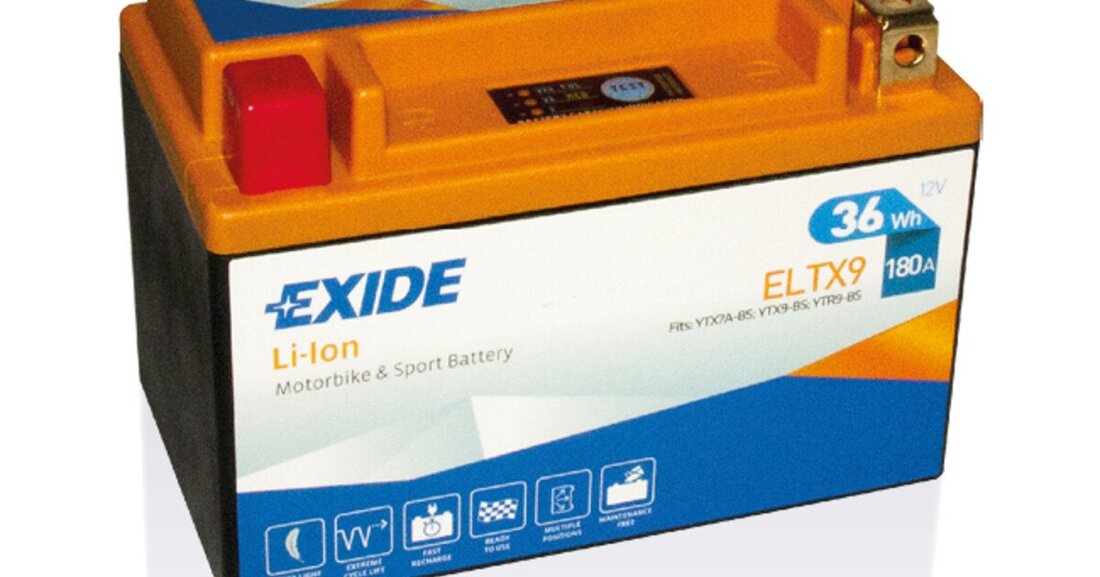Lithium ion starter batteries in cars
A commercially available lithium-ion starter battery for use in motor vehicles: compact, light, strong.

Lithium ion starter batteries in cars
Modern cars need powerful starter batteries, the keyword is: automatic start-stop system. In order to protect the environment and reduce emissions, almost all modern combustion engines switch off automatically when stationary (if the on-board electrical system deems it better). Accordingly, the car has to be started more often and the starter batteries have to perform many times more than they did a few years ago.

Crucial point: Batteries are subject to natural wear and tear. In series production, the most important thing is the price; here, lead-acid starter batteries are the clear leading technology with well over 90 percent. Note that Difference between AGM and EFB batteries.
However, there is currently a clearly visible trend towards lithium-ion starter batteries for motorcycles. Also in series production, but only on very expensive high-performance bikes. Lithium batteries are also successful in the aftermarket because they are significantly lighter and bikers can save a few kilos comparatively cheaply. Depending on where the battery is installed on the motorcycle, you can actually feel the weight savings when driving. “The main advantages of the lithium-ion battery in the two-wheeler sector (lower weight in racing, easier charging after several months of standstill in the winter) generally do not play a role in the four-wheeler sector,” says Thomas Bawart, technical managing director of Banner Batteries.
Exide Technologies takes a similar approach: "The main advantage that a lithium-ion battery brings is the weight saving of up to 70 percent. In the motorcycle and recreational sports sector, the relevance of this weight advantage often outweighs the advantages that the lead-acid battery offers."
The advantages of lithium-ion starter batteries are clear:
-
higher energy density, more power in smaller battery housings
-
50-70 percent weight savings compared to lead-acid batteries
-
Low self-discharge, high performance even after a long period of use
-
high charging currents and therefore short charging processes (but only with special chargers)
-
high number of possible charging cycles
-
Memory effect not noticeable for the end customer
Where there is light, there is also shadow.
These are the disadvantages of lithium-ion starter batteries:
-
Fire hazard
-
higher temperature instability
-
significantly higher costs
-
worse environmental balance
-
complicated, expensive recycling
One of the biggest disadvantages is thisPriceof lithium-ion starter batteries because they are significantly more expensive than classic lead-acid batteries. On the one hand, raw materials are needed that are rarer and more difficult to mine, which means they are automatically more expensive. On the other hand, lithium-ion batteries are also significantly more expensive to recycle because they have to be dismantled very laboriously. There are high costs for disposing of lithium-ion batteries, which have to be factored in, or at least in part, during production for a closed recycling cycle.
While a conventional oneLead-acid batteries can be almost 100 percent recycled, the recyclability of old, used or even defective lithium-ion starter batteries is significantly lower. Although some rare raw materials can be recovered from the battery using complex (=expensive) processes, these processes are not yet cost-effective. With large electric car batteries made of lithium, buffer or storage batteries can still be made from them if the capacity decreases. This is not possible with small 12-volt starter batteries and the entire disposal or recycling process becomes very expensive if you want to dispose of the batteries in an environmentally friendly manner.
Banner and Exide do not expect a trend reversal
Both Banner and Exide do not expect a timely trend reversal in the technology used in starter batteries.
"The fact is that conventional lead-acid batteries currently account for the lion's share of the global battery market, at around 90 percent. Industry estimates assume annual growth rates of two to three percent, so we are currently not seeing any large quantities of lithium starter batteries in the passenger car sector,"says Thomas Bawart.
Exide confirms:"The lead-acid battery is also the preferred starter technology in electric and hybrid vehicles. This is also confirmed by discussions with the development departments of automobile manufacturers.In practice, the lithium battery is currently only used as a starter battery in niche areas.“ According to Exide, 77 percent of electric fleets are currently equipped with a lead-acid starter battery.

 Suche
Suche
 Mein Konto
Mein Konto